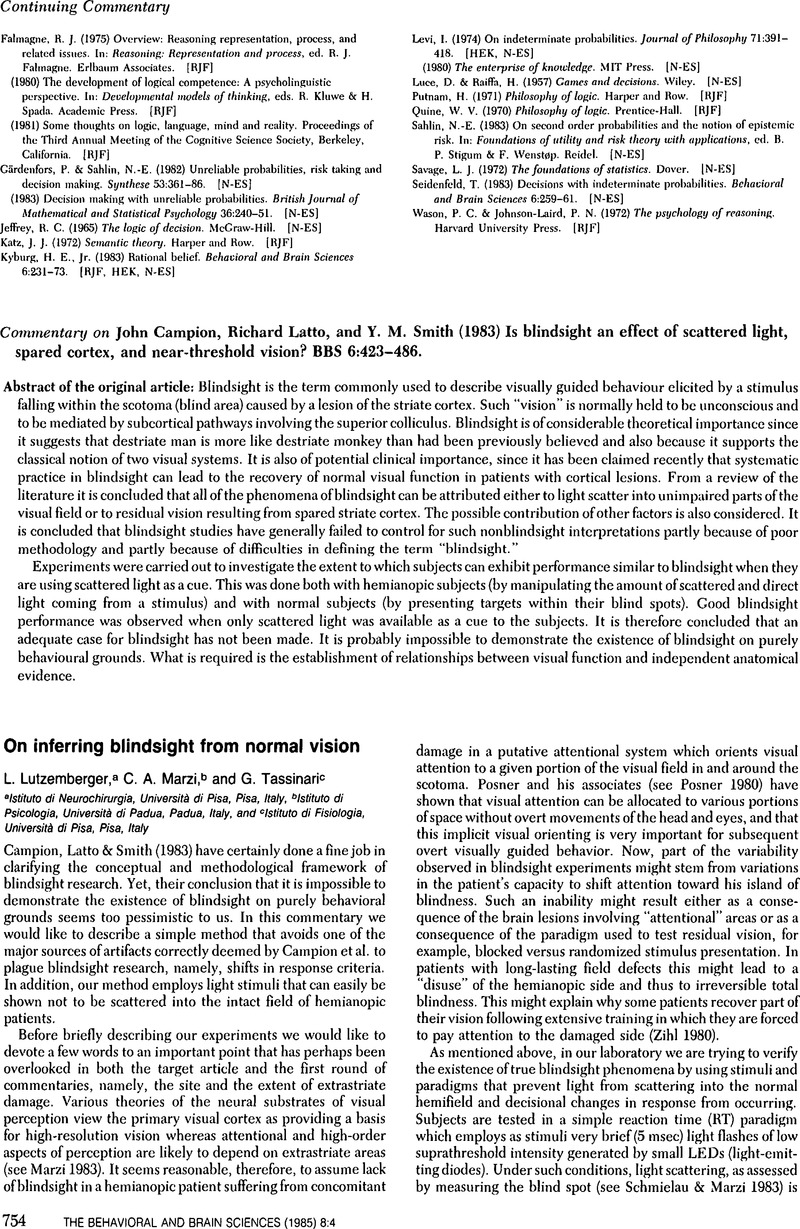Crossref Citations
This article has been cited by the following publications. This list is generated based on data provided by Crossref.
Merikle, Philip M.
and
Cheesman, Jim
1985.
Conscious and unconscious processes: Same or different?.
Behavioral and Brain Sciences,
Vol. 8,
Issue. 4,
p.
547.
Vanderwolf, C. H.
1985.
Nineteenth-century psychology and twentieth-century electrophysiology do not mix.
Behavioral and Brain Sciences,
Vol. 8,
Issue. 4,
p.
555.
MacKay, Donald M.
1985.
Do we “control” our brains?.
Behavioral and Brain Sciences,
Vol. 8,
Issue. 4,
p.
546.
Nelson, R. J.
1985.
Libet's dualism.
Behavioral and Brain Sciences,
Vol. 8,
Issue. 4,
p.
550.
Breitmeyer, Bruno G.
1985.
Problems with the psychophysics of intention.
Behavioral and Brain Sciences,
Vol. 8,
Issue. 4,
p.
539.
Danto, Arthur C.
1985.
Consciousness and motor control.
Behavioral and Brain Sciences,
Vol. 8,
Issue. 4,
p.
540.
Underwood, Geoffrey
and
Niemi, Pekka
1985.
Mind before matter?.
Behavioral and Brain Sciences,
Vol. 8,
Issue. 4,
p.
554.
Rugg, Michael D.
1985.
Are the origins of any mental process available to introspection?.
Behavioral and Brain Sciences,
Vol. 8,
Issue. 4,
p.
552.
Scheerer, Eckart
1985.
Conscious intention is a mental fiat.
Behavioral and Brain Sciences,
Vol. 8,
Issue. 4,
p.
552.
Wasserman, Gerald S.
1985.
Neural/mental chronometry and chronotheology.
Behavioral and Brain Sciences,
Vol. 8,
Issue. 4,
p.
556.
Ringo, James L.
1985.
Timing volition: Questions of what and when about W.
Behavioral and Brain Sciences,
Vol. 8,
Issue. 4,
p.
550.
Mortensen, Chris
1985.
Conscious decisions.
Behavioral and Brain Sciences,
Vol. 8,
Issue. 4,
p.
548.
Libet, Benjamin
1985.
Unconscious cerebral initiative and the role of conscious will in voluntary action.
Behavioral and Brain Sciences,
Vol. 8,
Issue. 4,
p.
529.
Libet, Benjamin
1985.
Theory and evidence relating cerebral processes to conscious will.
Behavioral and Brain Sciences,
Vol. 8,
Issue. 4,
p.
558.
Marks, Lawrence E.
1985.
Toward a psychophysics of intention.
Behavioral and Brain Sciences,
Vol. 8,
Issue. 4,
p.
547.
Stamm, John S.
1985.
The uncertainty principle in psychology.
Behavioral and Brain Sciences,
Vol. 8,
Issue. 4,
p.
553.
Wood, Charles C.
1985.
Pardon, your dualism is showing.
Behavioral and Brain Sciences,
Vol. 8,
Issue. 4,
p.
557.
Näätänen, R.
1985.
Brain physiology and the unconscious initiation of movements.
Behavioral and Brain Sciences,
Vol. 8,
Issue. 4,
p.
549.
Eccles, John C.
1985.
Mental summation: The timing of voluntary intentions by cortical activity.
Behavioral and Brain Sciences,
Vol. 8,
Issue. 4,
p.
542.
Doty, Robert W.
1985.
The time course of conscious processing: Vetoes by the uninformed?.
Behavioral and Brain Sciences,
Vol. 8,
Issue. 4,
p.
541.





